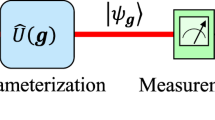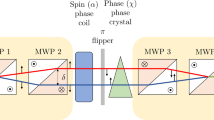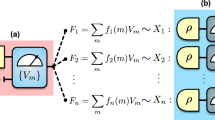Abstract
The uncertainty principle generally prohibits simultaneous measurements of certain pairs of observables and forms the basis of indeterminacy in quantum mechanics1. Heisenberg’s original formulation, illustrated by the famous γ-ray microscope, sets a lower bound for the product of the measurement error and the disturbance2. Later, the uncertainty relation was reformulated in terms of standard deviations3,4,5, where the focus was exclusively on the indeterminacy of predictions, whereas the unavoidable recoil in measuring devices has been ignored6. A correct formulation of the error–disturbance uncertainty relation, taking recoil into account, is essential for a deeper understanding of the uncertainty principle, as Heisenberg’s original relation is valid only under specific circumstances7,8,9,10. A new error–disturbance relation, derived using the theory of general quantum measurements, has been claimed to be universally valid11,12,13,14. Here, we report a neutron-optical experiment that records the error of a spin-component measurement as well as the disturbance caused on another spin-component. The results confirm that both error and disturbance obey the new relation but violate the old one in a wide range of an experimental parameter.
This is a preview of subscription content, access via your institution
Access options
Subscribe to this journal
Receive 12 print issues and online access
$259.00 per year
only $21.58 per issue
Buy this article
- Purchase on SpringerLink
- Instant access to full article PDF
Prices may be subject to local taxes which are calculated during checkout





Similar content being viewed by others
Change history
12 March 2012
In the version of this Letter originally published, in Fig. 5a a factor of ℏ/2 appeared incorrectly against the label 'Heisenberg lower limit' and in the figure caption. This error has been corrected in the HTML and PDF versions of the Letter.
01 August 2012
In the version of this Letter originally published, in the Methods section under the heading 'Error and disturbance in spin measurements: theoretical determination' the equation defining η(B) was incorrect — the term σϕ should have been divided by 2. This error has been corrected in the HTML and PDF versions of the Letter.
References
Wheeler, J. A. & Zurek, W. H. (eds) in Quantum Theory and Measurement (Princeton Univ. Press, 1983).
Heisenberg, W. Über den anschaulichen Inhalt der quantentheoretischen Kinematik und Mechanik. Z. Phys. 43, 172–198 (1927).
Kennard, E. H. Zur Quantenmechanik einfacher Bewegungstypen. Z. Phys. 44, 326–352 (1927).
Robertson, H. P. The uncertainty principle. Phys. Rev. 34, 163–164 (1929).
Schrödinger, E. Zum Heisenbergschen Unschärfeprinzip. Sitz. Preuss. Akad. Wiss. 14, 296–303 (1930).
Ballentine, L. E. The statistical interpretation of quantum mechanics. Rev. Mod. Phys. 42, 358–381 (1970).
Arthurs, E. & Kelly, J. L. Jr On the simultaneous measurement of a pair of conjugate observables. Bell Syst. Tech. J. 44, 725–729 (1965).
Arthurs, E. & Goodman, M. S. Quantum correlations: A generalized Heisenberg uncertainty relation. Phys. Rev. Lett. 60, 2447–2449 (1988).
Ishikawa, S. Uncertainty relations in simultaneous measurements for arbitrary observables. Rep. Math. Phys. 29, 257–273 (1991).
Ozawa, M. in Quantum Aspects of Optical Communications. (eds Bendjaballah, C., Hirota, O. & Reynaud, S.) (Lecture Notes in Physics, Vol. 378, 3–17, Springer, 1991).
Ozawa, M. Universally valid reformulation of the Heisenberg uncertainty principle on noise and disturbance in measurements. Phys. Rev. A 67, 042105 (2003).
Ozawa, M. Physical content of the Heisenberg uncertainty relation: Limitation and reformulation. Phys. Lett. A 318, 21–29 (2003).
Ozawa, M. Uncertainty relations for noise and disturbance in generalized quantum measurements. Ann. Phys. 311, 350–416 (2004).
Ozawa, M. Universal uncertainty principle in measurement operator formalism. J. Opt. B 7, S672–S681 (2005).
Shull, C. G. Single slit diffraction of neutrons. Phys. Rev. 179, 752–754 (1969).
Yuen, H. P. Two-photon coherent states of the radiation field. Phys. Rev. A 13, 2226–2243 (1976).
Breitenbach, G., Schiller, S. & Mlynek, J. Measurement of the quantum states of squeezed light. Nature 387, 471–475 (1997).
Appleby, D. M. The error principle. Int. J. Theor. Phys. 37, 2557–2572 (1998).
Werner, R. F. The uncertainty relation for joint measurement of position and momentum. Quant. Inf. Comput. 4, 546–562 (2004).
Busch, P., Heinonen, T. & Lahti, P. Heisenberg’s uncertainty principle. Phys. Rep. 452, 155–176 (2007).
Klepp, J. et al. Observation of nonadditive mixed-state phases with polarized neutrons. Phys. Rev. Lett. 101, 150404 (2008).
Koshino, K. & Shimizu, A. Quantum Zeno effect by general measurements. Phys. Rep. 412, 191–275 (2005).
Mir, R. et al. A double-slit ‘which-way’ experiment on the Complementarity–uncertainty debate. New J. Phys. 9, 287 (2007).
Lund, A. P. & Wiseman, H. M. Measuring measurement–disturbance relationships with weak values. New J. Phys. 12, 093011 (2010).
Williams, G. Polarized Neutrons (Oxford Univ. Press, 1988).
Yuen, H. P. Contractive states and the standard quantum limit for monitoring free-mass positions. Phys. Rev. Lett. 51, 719–722 (1983).
Ozawa, M. Measurement breaking the standard quantum limit for free-mass position. Phys. Rev. Lett. 60, 385–388 (1988).
Maddox, J. Beating the quantum limits. Nature 331, 559 (1988).
Nielsen, M. A. & Chuang, I. Quantum Computation and Quantum Information (Cambridge Univ. Press, 2000).
Kraus, K. States, Effects, and Operations: Fundamental Notions of Quantum Theory (Lecture Notes in Physics, Vol. 190, Springer, 1983).
Acknowledgements
We acknowledge support by the Austrian Science Fund (FWF), the European Research Council (ERC), the Japan Science and Technology Agency (JST) and The Ministry of Education, Culture, Sports, Science and Technology (MEXT) in Japan. We thank H. Rauch, M. Arndt (Vienna) and A. Hosoya (Tokyo) for their helpful comments.
Author information
Authors and Affiliations
Contributions
J.E., G.S. and S.S. carried out the experiment and analysed the data; G.B. contributed to the development at the early stage of the experiments; M.O. supplied the theoretical part and conceived the experiment; Y.H. conceived and carried out the experiment; all authors co-wrote the paper.
Corresponding author
Ethics declarations
Competing interests
The authors declare no competing financial interests.
Rights and permissions
About this article
Cite this article
Erhart, J., Sponar, S., Sulyok, G. et al. Experimental demonstration of a universally valid error–disturbance uncertainty relation in spin measurements. Nature Phys 8, 185–189 (2012). https://doi.org/10.1038/nphys2194
Received:
Accepted:
Published:
Issue date:
DOI: https://doi.org/10.1038/nphys2194
This article is cited by
-
Error tradeoff uncertainty relations for three observables
Quantum Information Processing (2024)
-
Strong majorization uncertainty relations and experimental verifications
npj Quantum Information (2023)
-
Specific relativistic uncertainty in light transmission with angular orientation non-zero
Applied Physics B (2023)
-
Uncertainty relations for triples of observables and the experimental demonstrations
Science China Physics, Mechanics & Astronomy (2023)
-
Improved unitary uncertainty relations
Quantum Information Processing (2022)



